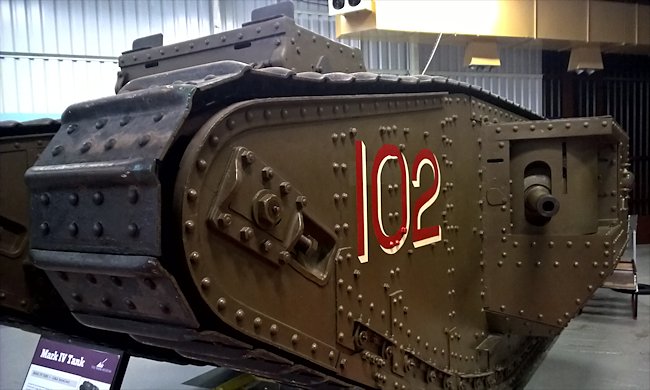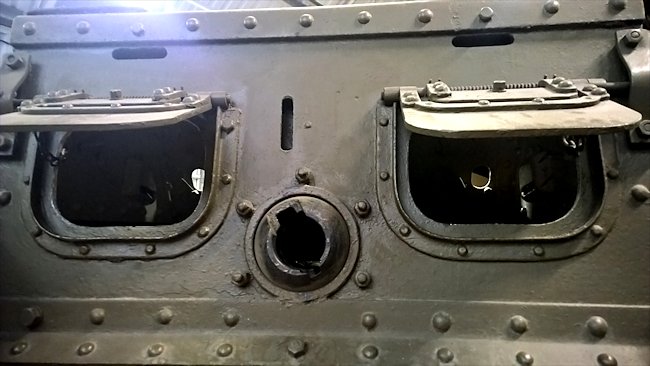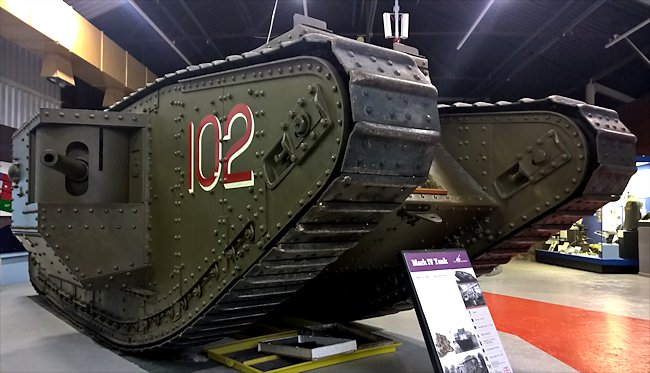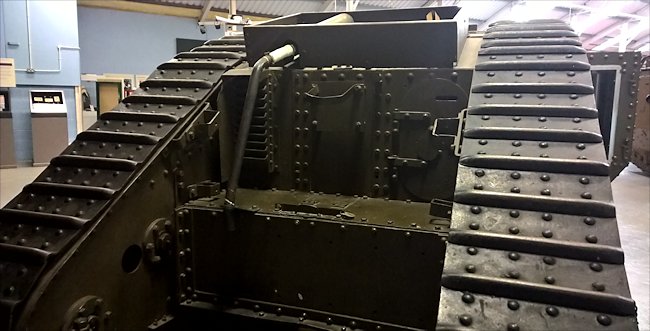Mark IV Male Tank
This WW1 British Mark IV tank can be found at the Tank Museum, Bovington, Dorest, BH20 6JG, England. Their website is tankmuseum.org.

The up-armoured WW1 British Mark IV Male Tank with shorter the 6pdr gun but without its roof rails. After WWI this tank had been gifted to HMS Excellent, the Royal Navy gunnery school, for their help in training tank crews. During WW2, it was made operational again for service with the Home Guard when German invasion threatened in 1940 but the only action it saw was when it damaged a private car.
It required a tank crew of eight men and had a top speed of only 3.7mph (6 km/h). It was manufactured by William Foster and Co Ltd in Lincoln and other UK firms. It saw operational service between 1917 and 1918. It was one of the first tanks to be mass produced and became the mainstay of the British Tank Corps. The Mark IV tank has the honour of being the first British tank to be involved in tank on tank combat when shots were fired at three German A7V tanks in April 1918.

Driver's porthole on a WW1 British Mark IV Male Tank
The mass attack of Mark IV tanks at the Battle of Cambrai
The Mark IV British tank was introduced in 1917. The major improvement in the tank over the Mark I was in its armour. It now had better protection from heavier caliber machine guns. There were 420 Mark IV Male tanks made and 595 Mark IV female machine gun only support tanks. The .303 Lewis machine gun was now used in this next generation of British tank. The Male Mark IV had three machine guns. One in the front hull and one in the left and right sponson. The female tank had five machine guns. Two in each side sponson and one in the front hull armour. The 6pdr gun used on the male tanks was now the shorter barreled QF 6pdr 6 cwt (57mm) gun.
The Battle of Messines Ridge 7th to 14th June 1917 was the first battle in which the Mark IV tank saw action. They were used again during the Battle of Cambrai 20th November 1917. This battle is always talked about as the first successful use of large masses of tanks during an attack. What is often forgotten is the success of the newly introduced German direct fire anti-tank gun and that all success gained during the attack were reversed in a few weeks following the battle.

The WW1 British Mark IV Male Tank weighed 28 Tonnes
The motto of the newly formed WW1 British Tank Corps was 'through the mud and the blood to the green fields beyond' and that break out ability was what had been looked for by the military throughout the Great War. At the Battle of Cambrai the Tank Corps lived up to its Motto.
By using hundreds of tanks the Allies hoped to punch holes through the German’s defensive Hindenburg Line and reach the town of Cambrai. The Germans had made this section of the line one of the most heavily defended stretches. They had more they more than 250,000 troops. Hundreds of machine gun posts and a maze of barbed wire. For the first time they had built specific counter measures against tanks. They had widened their trenches to 16 feet wide to make them difficult to cross.

Rear view of a WW1 British Mark IV Male Tank
On 20th November 1917 200,000 allied troops and 432 tanks were poised on an all-out strike on the Hindenburg Line. Major William H.L.Watson, D Battalion, Tank Corps, was in one of the attacking Mark IV tanks, "To the right of me and to the left of me, in the dim light, were tanks. Tanks lined up in front of the wire. Tanks swinging into position. There was one tank to every 30 yards of front. When the British Artillery guns began the tanks were moving over the precipice of the hill. The enemy trenches were already enveloped in thick smoke."
The German defenders were taken by surprise. Leutnant A. Saucke of the 6th Company, 84th Infantry Regiment was in the trenches at the time of the attack. "All hell broke loose. I could see the trench lit up by a sea of flame caused by the incessant exploding shells. Then we saw a whole line of these steel monsters approaching our trenches. I clung on to the hope that the trenches would be wider enough to present an impassable obstacle to the tanks."
The Royal Flying Corps spotter aircraft had noticed that the Germans had increased the width of their trenches to trap any tank that tried to cross it. The British knew they needed a secret weapon that would help the tanks negotiate these new ant-tank obstacle. The answer they came up with had first been used in medieval times by knights in armour who needed to cross a moat to capture a castle.
The British tied huge bundles of long thin tree branches, bound with chains, to the top of each tank. These bundles of wood were called a ‘fascine’ and measured about 10 feet (3.0 m) long and 4½ feet (1.4 m) wide. Whilst one tank was dropping their wood fascine into the trench a Mark IV female tank would turn sideways and machine gun the length of the trench.
German infantry Leutnant A. Mestward said of this moment in the battle, "The tanks made rapid progress, crossing the trench to our left and right whilst maintaining heavy fire against the trench. We were utterly defenceless in the face of these monsters. This was no longer a battle. This was a massacre."
It seemed to promise to be an overwhelming victory. The British Mk IV tanks had passed the trench system and were now in open country heading towards their objective, the town of Cambrai, which could be seen in the distance on top of a hill. The battle of Cambrai was far from over. The German Army also had a secret weapon and it was hiding behind bushes near the village of Flesquières waiting for the tanks to come into its sights.
The Mark IV tanks of H Battalion, Tank Corps were moving up a slope, 2nd Lt Gordon Hassel in his tank named ‘Harrier’ remembers feeling uneasy when they reached the top and stopped. He could see Cambrai but the ground in front of them was unusually devoid of the enemy. "I said to my driver, I don’t like this somehow. I don’t know why." It looked too good to be true. Too easy. Suddenly a shell from a field gun that was waiting in a carefully planned ambush hit a tank called ‘Hong Kong’ and destroyed it. The others tried desperately to escape its range.
2nd Lt Gordon Hassel recollected, "We were going downhill and managed to get up a bit of speed. I then heard a tremendous explosion and saw one of our tracks go flying through the air. But then we got another hit which carried away our roof. Then the third shot crashed through the back and we were out of action.
The gun that destroyed ‘Harrier’ also hit ‘Huntsman’ and ‘Harvester’. The weapon that was causing so much damage was the 77mm Krupp Feldkanone 16 Field Gun. It was originally designed for indirect artillery fire, it had been modified for direct fire against tanks. It was lethal. Its 6kg armour piercing shells were accurate over distances over one mile.
Where can I find other preserved Mark IV Tanks?
- Mark IV Male - Tank Museum Bovington, England
- Mark IV Male - Royal Museum of the Armed Forces, Brussels
- Mark IV Female - Museum of Lincolnshire Life, Lincoln England
- Mark IV Female - St George's Square, Ashford, Kent, England
- Mark IV Female - Flesquières, France
- Mark IV Female - Australian War Memorial, Canberra, ACT, Australia
- Mark IV Female - National Armor and Cavalry Museum, Fort Benning, GA, USA
- Source - Pierre-Oliver Buan - http://the.shadock.free.fr/Surviving_Panzers.htm
WW1 Tank books

